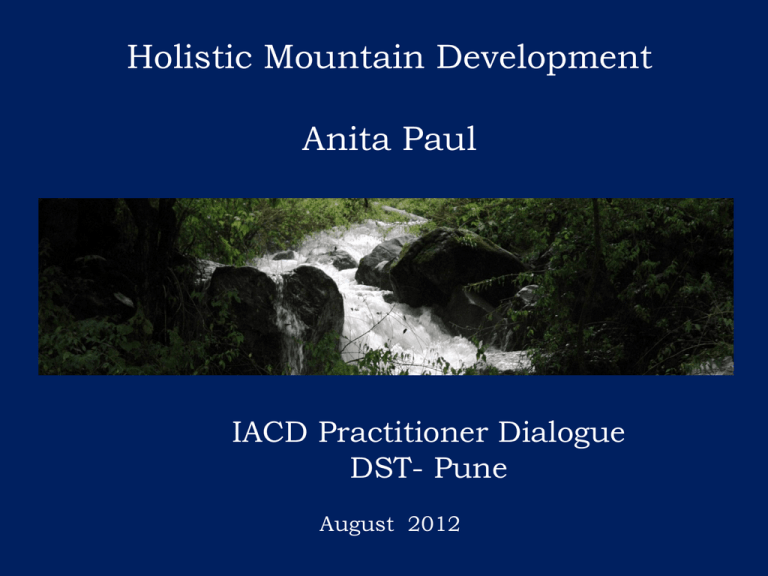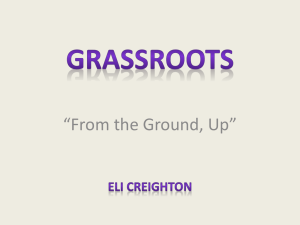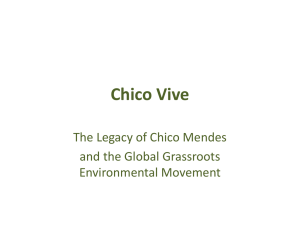holistic_mountain_development_anita_paul
advertisement

Holistic Mountain Development Anita Paul IACD Practitioner Dialogue DST- Pune August 2012 The Pan Himalayan Grassroots Development Foundation is a non-profit organization working in the central and western Himalaya since 1992. The primary aim of Grassroots is to initiate peoples action at the grassroots for restoration of ecological security in languishing river basins through holistic mountain development programs, in order to improve the quality of life. Grassroots 2 The loss or lack of title to environmental assets is viewed as a component of poverty, leading to the conclusion that environmental conservation is actually a necessary fundamental to poverty alleviation. Also implied in the mandate of Grassroots and incorporated in its approach and methodology is promotion of the entrepreneurial spirit - the belief that people can determine their own destiny, establish goals, take risks and invest their time and energy to achieve their aspirations for a better life. Grassroots 3 Based on the vulnerability of communities, Grassroots is focusing on the following thematic areas: • Infiltration Wells • Rainwater Harvesting • Toilets • • • • • Biogas Units • Solar Lights Water & Sanitation Renewable Energy Ecological Security Livelihoods & Micro Enterprises Vegetal Cover Hydrology Biodiversity Farming Systems • Self Help Groups • Producer Groups • Guilds Grassroots 4 Grassroots 5 Over the past 20 years, in partnership with various civil society organisations and the government, the outreach programs of Grassroots has benefitted communities spread over 800 villages in 12 districts in the states of Uttarakhand and Himachal Pradesh, India. Grassroots 6 Our Strategy Programs •Renewable- energy •Sanitation •Water •Community Forestry •Farming Systems •Livelihoods •Climate Change Principles •Ecology •Economy •Equity Holistic Mountain Development Strategies Grassroots aims to initiate peoples action at the grassroots for restoration of ecological security in languishing river basins to improve the quality of life •Capacity Building •Empowerment •Cost sharing •Leadership •Partnerships Grassroots 7 Location Map of the Gagas Basin Total area of the basin 512 km2 Grassroots 8 Basic Data • Area 500 square kms • Altitude Between 4,000 feet to 8,000 feet • Villages 373 • Rural Population 100,000 • Urban Population 20,000 • Major Gadheras 14 • No of Households 23,000 • Reserved Forests 20 percent of the basin 9 Grassroots 14 major gadheras/streams drain into the river Grassroots 10 373 Villages spread over the Basin Grassroots 11 State of Reserved Forests Grassroots 12 Problems of Water Resources in a Typical Gadhera Grassroots 13 Support Area for Sustainable Farming • Typically, we need 7 hectares of forest areas to support 1 hectare of farming • In most river basins, like Gagas, the ratio is 1:1 • Which has led to food insecurity and impoverishment • And, migration to urban sweatshops Grassroots 14 Forests & Water Grassroots 15 Women are playing a key role to renew the hydrology in the river basin Grassroots 16 Kumaon Artisans Guild Grassroots experiences of promoting MDGs has led to the consolidation of artisans guilds which comprises of local youth trained as barefoot engineers in order to spread the benefits of appropriate technologies in cross cutting sectors like drinking water, environmental sanitation, renewable energy and rain water harvesting – with the idea of improving the quality of life for mountain communities here and now. These guilds have also led to the creation of significant sustainable employment opportunities. On an average, a skilled artisan would earn Rs. 75,000 per annum. Grassroots 17 Infiltration Wells in the Himalaya! Grassroots 18 Appropriate Technology for Community Managed Drinking Water Systems • 40 % of traditional water sources have dried-up • Spread to 350 villages, 54 blocks, 11 districts of Uttarakhand & Himachal Pradesh • Providing 2.4 million litres of safe drinking water to 17,600 households with close to 100,000 people Grassroots 19 Sanitation • 4,000 households • In Dusad, 100% households have installed sanitation units Grassroots 20 Rainwater Harvesting Roof runoff rainwater harvesting tanks supplement availability of domestic water – demonstrations in schools have led to 500 households adopting this AT application 21 Grassroots Renewable Energy Grassroots 22 Biogas Units • Biogas units provide four hours of clean cooking gas daily • Reduces the drudgery of head loading firewood • Reduces biotic pressure • Reduces health hazard of smoky open fires • Also ‘burns’ methane – one of the four obnoxious gases leading to global warming • 2,400 households have now access to clean energy for cooking through Bio-gas Grassroots units 23 Consolidated Biogas & IW details from 1993-94 to 2011-12 S No State District 1 Uttarakhand Almora Block Biogas 276 290 582 Bageshwar 2 70 46 131 Champawat 2 3 6 - Nainital 7 111 43 469 Pithoragarh 4 40 7 72 Tehri 8 39 42 16 Chamoli 5 13 18 23 10 20 20 17 Rudraprayag 2 16 25 - Dehradun 2 40 - 194 53 628 497 1,504 Sirmaur 6 124 29 895 Shimla 1 1 1 - Solan 1 11 8 26 Sub-Total Himachal Pradesh IWs 11 Pauri 2 Villages 10 Sub-Total 3 8 136 38 921 Total 13 61 764 535 2,425 Grassroots 24 Catchment Area Treatment • As of now 9,50,000 saplings raised and planted-out in protected village commons • Output of grasses have increased • Equity & governance Grassroots 25 Village Nurseries raise Appropriate Rootstock of Native Species Grassroots 26 Planting Trees… Grassroots 27 Revival of a Tradition • Khals assisted the process of recharging the ground water till the alienation of communities from forests • Currently, communities are in dialogue with the government to revive this tradition, especially in the reserved forest areas Grassroots 28 Degraded commons – 10 years later with fresh vegetal cover Grassroots 29 Community Owned Enterprises Grassroots 30 It is realised that human development is about much more than rise or fall of national incomes. It is about quality of life, the level of human wellbeing and the access to basic social services. The pressures on environmental and natural resources and the repercussions of their degradation on low income livelihoods have become a source of increasing concern. Innovative micro-enterprises are necessary in order to address this situation. Grassroots 31 Livelihoods & Microenterprises • To secure and consolidate a fresh balance in the quality of their lives, SHGs have been involved with creating a platform for establishment of pro poor business ventures with farming families as the primary stakeholders federated in the form of a Producers Company – Community Owned Social Enterprise. Grassroots 32 UMANG – Producers Company • • • • • Network of 1,500 women Formed into 200 SHGs In 100 villages Savings of Rs. 50 lakhs plus Supplementing incomes through various verticals, viz., fruit preserves/pickles unit, hand-knitted items, safe foods, backyard poultry, etcetera. Grassroots 33 Off-Farm Livelihoods Grassroots 34 Consolidating Organic Farming Systems Grassroots 35 Linking Markets for Traditional Crops Grassroots 36 Value Added Crops Grassroots 37 Free Range Poultry • Over 500 households with an average of 10 chicks of kroiler birds (350 grams + vaccinated) • Average earning per year = Rs. 5,000 • Plus the benefit of eggs at home • This business of Rs. 25 lacs per annum could be expanded 100 times, but we would need to organize marketing Constraints Setting up ‘mother farms’ Distribution of chicks Grassroots 38 UMANG - Members Income Chart 50% 45% 40% Nos (in%) 35% 30% 2009-10 25% 2010-11 20% 2011-12 15% 10% 5% 0% 1-1000 1001-2500 2501-5000 5001-10000 Earning Range (in Rs) Note: Income chart is combination of different verticals more than 10001 UMANG – Sale Comparison Chart 10,000,000 9,000,000 Sale Amount (in Rs) 8,000,000 7,000,000 6,000,000 5,000,000 4,000,000 3,000,000 2,000,000 1,000,000 0 2002-03 2003-04 2004-05 2005-06 2006-07 2007-08 2008-09 2009-10 2010-11 2011-12 Year Duration Capacity Building – Grassroots Institutions! Grassroots 41 Grassroots Interface We would continue to act as an interface between communities and other stake holders for promoting sustainable mountain development Grassroots 42 Thank You for your Time! Pan Himalayan Grassroots Development Foundation Post Bag # 3, Ranikhet 263 645, Almora District, Uttarakhand, India apaul@grassrootsindia.com Grassroots 43









